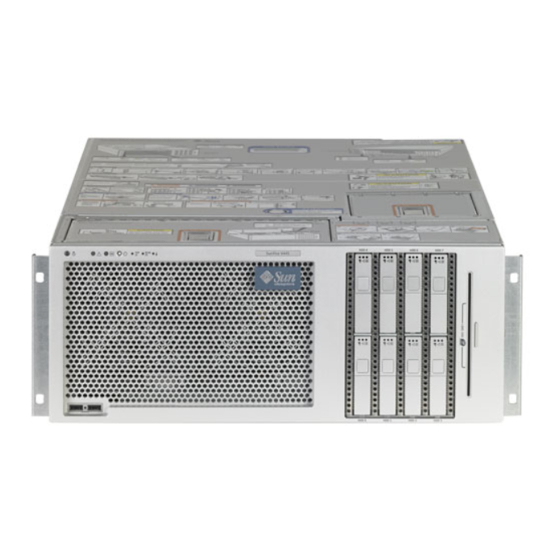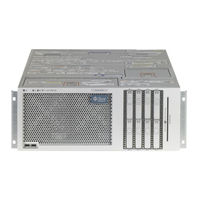
Sun Microsystems Sun Fire V445 Manuals
Manuals and User Guides for Sun Microsystems Sun Fire V445. We have 4 Sun Microsystems Sun Fire V445 manuals available for free PDF download: Administration Manual, Service Manual, Installation Manual
Sun Microsystems Sun Fire V445 Administration Manual (294 pages)
Brand: Sun Microsystems
|
Category: Server
|
Size: 2 MB
Table of Contents
-
Preface
27 -
-
-
New Features39
-
-
Power Button44
-
USB Ports44
-
-
-
-
-
-
-
Hard Disk Drives118
-
Power Supplies118
-
System Fan Trays119
-
USB Components119
-
-
-
-
Stop-A Function142
-
Stop-N Function142
-
-
-
-
8 Diagnostics
183-
-
Table 6204
-
-
Probe-Scsi-All214
-
Probe-Ide214
-
Show-Devs216
-
-
-
Reset Scenarios244
-
About Sunvts247
-
Advertisement
Sun Microsystems Sun Fire V445 Administration Manual (272 pages)
Brand: Sun Microsystems
|
Category: Server
|
Size: 4 MB
Table of Contents
-
Figures
17-
Preface
21 -
-
-
USB Ports30
-
New Features33
-
-
Power Button37
-
USB Ports37
-
-
-
-
-
-
Hard Disk Drives106
-
Power Supplies106
-
System Fan Trays107
-
USB Components107
-
-
-
-
Stop-A Function130
-
Stop-N Function130
-
Stop-D Function131
-
Stop-F Function131
-
-
-
-
8 Diagnostics
163-
-
-
Probe-Scsi-All194
-
Probe-Ide195
-
-
-
-
Reset Scenarios224
-
About Sunvts227
-
Using Sunvts228
-
-
-
Product Notes236
-
Sunsolve Online236
-
Web Sites236
-
Big Admin237
-
-
-
-
-
Sun Microsystems Sun Fire V445 Service Manual (212 pages)
Brand: Sun Microsystems
|
Category: Server
|
Size: 12 MB
Table of Contents
-
Preface
19 -
-
-
Power Button29
-
USB Ports30
-
-
-
-
-
What to Do41
-
What Next42
-
-
What to Do42
-
What Next43
-
-
What to Do44
-
What Next45
-
-
What to Do47
-
What Next49
-
-
What to Do50
-
What Next51
-
-
What to Do52
-
What Next53
-
-
What to Do53
-
What Next54
-
-
What to Do55
-
What Next60
-
-
What to Do61
-
What Next64
-
-
What to Do65
-
What Next67
-
-
-
What to Do71
-
What Next72
-
-
What to Do73
-
What Next74
-
What to Do75
-
What Next76
-
-
What to Do77
-
What Next78
-
-
What to Do80
-
What Next80
-
-
What to Do82
-
What Next82
-
-
What to Do83
-
What Next84
-
-
What to Do85
-
-
What to Do86
-
What Next89
-
-
-
What to Do90
-
What Next93
-
-
-
What Next96
-
What to Do96
-
-
What to Do97
-
What Next98
-
-
-
About the Dimms104
-
About the IDPROM106
-
-
Before You Begin107
-
What to Do108
-
What Next109
-
-
-
Before You Begin110
-
What to Do110
-
-
What Next112
-
Removing a DIMM113
-
Before You Begin113
-
What to Do113
-
What Next115
-
-
-
Before You Begin116
-
What to Do116
-
What Next117
-
-
-
Before You Begin117
-
What to Do118
-
What Next119
-
-
-
Before You Begin120
-
What to Do120
-
What Next121
-
-
-
Before You Begin122
-
What to Do122
-
What Next123
-
-
-
Before You Begin123
-
What to Do123
-
What Next124
-
-
-
Before You Begin124
-
What to Do125
-
What Next125
-
-
-
Before You Begin125
-
What Next126
-
-
-
Before You Begin126
-
What to Do126
-
What Next127
-
-
-
Before You Begin128
-
What to Do128
-
What Next129
-
-
-
Before You Begin130
-
What to Do130
-
What Next132
-
-
-
Before You Begin133
-
What to Do133
-
What Next136
-
-
-
-
-
Before You Begin138
-
What to Do138
-
What Next139
-
-
-
Before You Begin139
-
-
What to Do139
-
What Next140
-
-
Before You Begin141
-
What to Do141
-
What Next142
-
-
-
Before You Begin143
-
What to Do143
-
What Next144
-
-
-
Before You Begin145
-
What to Do146
-
What Next147
-
-
-
Before You Begin147
-
What to Do148
-
What Next149
-
-
-
Before You Begin150
-
What to Do151
-
What Next151
-
-
-
Before You Begin152
-
What to Do152
-
What Next153
-
-
-
Before You Begin154
-
What to Do154
-
What Next155
-
-
Before You Begin156
-
What to Do156
-
What Next157
-
-
-
Before You Begin158
-
What to Do158
-
What Next160
-
-
-
Before You Begin161
-
What to Do161
-
What Next163
-
-
-
Before You Begin163
-
What to Do163
-
What Next164
-
-
-
Before You Begin164
-
What to Do164
-
What Next165
-
-
-
Before You Begin165
-
What to Do166
-
What Next167
-
-
Before You Begin167
-
What to Do167
-
What Next168
-
-
-
Before You Begin169
-
What to Do170
-
What Next170
-
-
-
Before You Begin171
-
What to Do171
-
What Next171
-
-
Advertisement
Sun Microsystems Sun Fire V445 Installation Manual (66 pages)
Brand: Sun Microsystems
|
Category: Server
|
Size: 3 MB
Table of Contents
Advertisement
Related Products
- Sun Microsystems Sun Fire V40z
- Sun Microsystems Sun Fire V490
- Sun Microsystems Sun Fire V440
- Sun Microsystems Sun Fire V480
- Sun Microsystems Fire V440 2-Post
- Sun Microsystems Sun Fire V120
- Sun Microsystems Fire V125
- Sun Microsystems Sun Fire V65 Series
- Sun Microsystems Sun Fire V60 Series
- Sun Microsystems Sun Fire V880z



